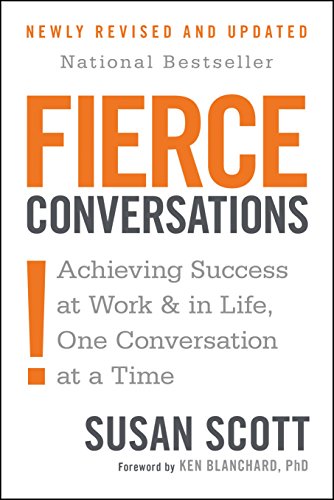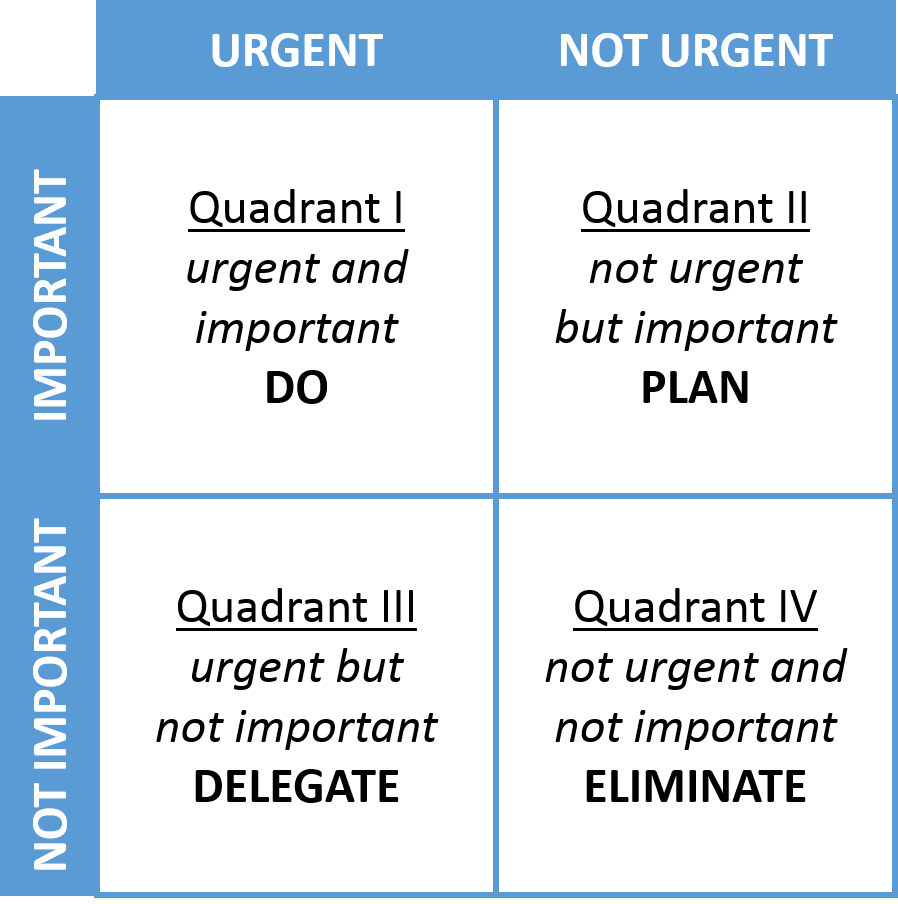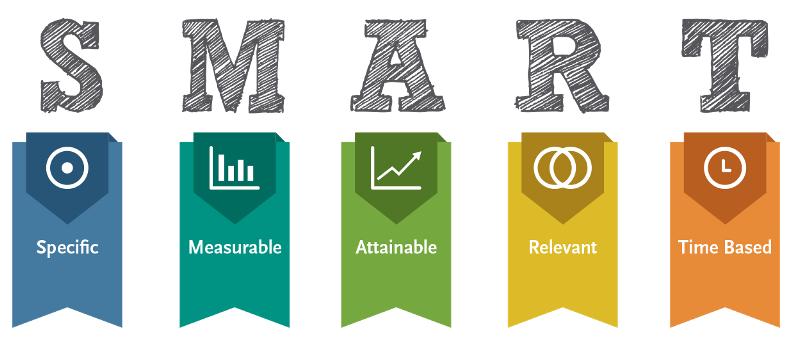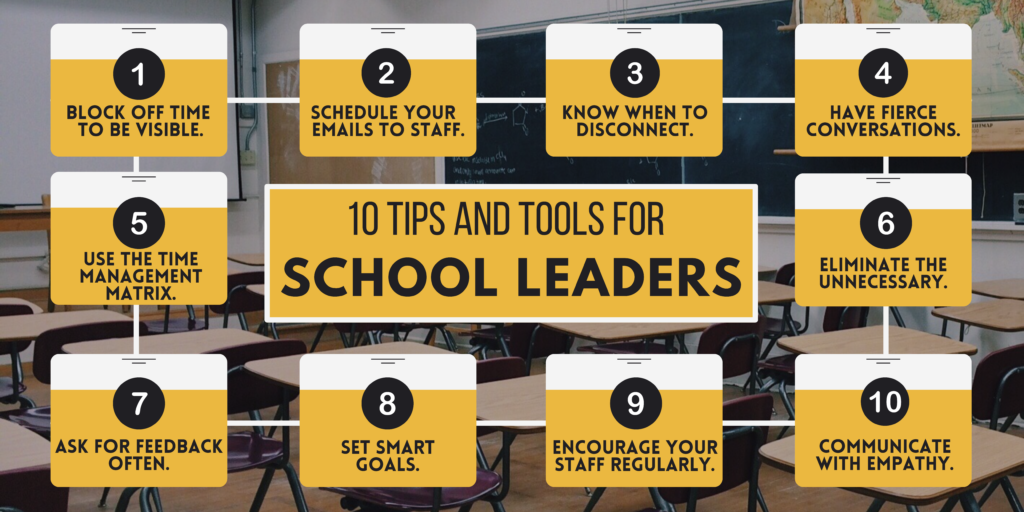Every leader has successes and failures. Ups and downs. Strengths and weaknesses. I want to start by saying that I am clearly not writing this article from the perspective of a former school leader who is an expert and who perfectly led her staff and school to success. Nope. I am writing this article as a former school leader who loved the work, but who also found it challenging and difficult; who had successes, but also learned from making mistakes. I am writing as a former school leader who absolutely loved being in leadership and who experienced growth, learning, and improvement over time, thanks to her incredible former faculty, staff, school community, and many wonderful mentors who shared their wisdom and provided a listening ear. I am sharing with you some tools that helped me along the way and some important lessons that I learned in the hope that you’ll find them beneficial. Some of these I’m still working on today, just in a different setting.
1. Block Off Time to Be Visible
Last year when I was a principal, I sat across from an elementary teacher during an informal check in. As part of the check in, I asked her for feedback. “Well, we need to see you more.” I was surprised to hear this. I felt like I WAS pretty visible! I asked her if she would mind explaining further. “We all feel more isolated this year. We don’t see each other as much as we did pre-pandemic, and we work more in classroom silos. People feel more alone. You are the person that connects us as the leader, and I just don’t see you in the hall or in my classrooms as much this year. We just need to see you more, and other teachers feel the same.”
Whoa. It was true. I had taken on more tasks since the administrative staff at the school had decreased in size, and these tasks kept me in my office more. And I didn’t even realize it. As a leader, you play a massive role in setting the tone of the atmosphere and building your school’s culture. Being visible reminds students, faculty, and staff that you are there for them, not just as someone observing and evaluating their work. Your presence matters. Being in classrooms, hallways, and in the library, around students and faculty, is one of the biggest joys in school leadership. Why not make time for it? It’s not easy, and it will always be a battle of priorities, but this should be at the top of the list.
A few considerations for visibility:
- Block off “untouchable” time in your calendar to visit classrooms, even if it’s just 20 minutes a day.
- Greet students, teachers, and families at the school entrance to begin the day and say goodbye at the end of the day. If you can’t do both, pick one. But be consistent and stick with it.
- Ask teachers about special projects or presentations you can pop in on, then schedule these visits in your calendar. If you say you’ll be there, don’t miss it.
- Spend some time in the teachers’ lounge and/or in the kitchen.
- Ask your faculty and staff how they’d like for you to be visible. They may offer suggestions you’ve not thought of.
2. Schedule Your Emails to Staff
I had a lot of discussions with my faculty about reasonable work hour expectations, setting boundaries, and taking time to disconnect. We talked about not answering emails after 5:00 p.m. and how they were not expected to answer emails over the weekend. One teacher came to see me after a discussion on this topic. “But Emily, you are ALWAYS emailing. You email on the weekend, at 11:00 p.m., early in the morning. You’re always on! This makes us feel like we have to be ‘on,’ too.” This was a wake-up call. As a leader, you do a lot of modeling, whether it’s intentional or not.
As a supervisor/manager/leader, your staff may feel obligated to answer emails from you in a “timely manner” or immediately. And if you are emailing at all hours of the day and night, this can send a message that your faculty should be doing the same. My biggest takeaway from this conversation: schedule emails to be sent during work hours. You might write that email at 1:00 a.m. on Saturday, but you can schedule it to be sent at 7:30 a.m. on Monday. Don’t know how to do that? Here are some great articles on how to schedule emails in Gmail and Outlook. And here is a video on how to schedule emails in Gmail:
3. Know When to Disconnect
Now, I know I just referenced sending emails at all hours of the day and night. But that doesn’t mean I believe you should. It’s important to know when to stop. A principal and dear friend I worked with in school administration once told me, “The work will still be here tomorrow. And if you finish this work today, there will just be more waiting for you in the morning.” And it’s true. There is nothing so urgent and important that justifies giving up time with your friends and family or giving up self-care to complete.
Here are some ideas for setting boundaries:
- Set work hours. Maybe this is something that’s set from the get-go, or maybe this is something you decide on each day based on what’s on your calendar. But decide your “stop” time and stick to it.
- If it is hard for you to stop working, ask someone to hold you accountable.
- Practice being “okay” with leaving a task or tasks unfinished at the end of the day, even if it is something important.
4. Have Fierce Conversations
One of the most influential books I’ve read as a leader was Fierce Conversations by Susan Scott. I am not a person who likes conflict, and I used to avoid it at all costs. This book changed the way I think about and approach challenging discussions.

As a leader, it is imperative to push into conflict, be honest with yourself and others, seek resolution, and sometimes just listen in order for your school culture to be healthy and positive. It is also necessary for accountability. In her book, Susan outlines seven principles for fierce conversations. These can be a powerful tool for developing clear and effective communication, being assertive, using feedback, and building a foundation of trust by pushing into the discomfort of some conversations. It’s a skill to be practiced and honed, and it will change you and your school culture for the better. How can you solve problems if they aren’t discussed? Or even more concerning, how can you solve problems if you aren’t aware they exist because your staff feels they can’t truly share with you?
5. Use Covey’s Time Management Matrix
This has been an invaluable tool for me. If you’re not familiar with it, Stephen R. Covey introduced this matrix in his book The Seven Habits of Highly Effective People. It is a simple way to manage your time and your priorities by placing them into one of four quadrants. As a principal, I often did this visually, on a whiteboard, or using sticky notes, my favorite office supply. This tool can be a game-changer when trying to distinguish between, plan for, and accomplish multiple competing priorities. Here is a great article that explains the matrix and how it can be beneficial.

6. Eliminate the Unnecessary
Take a look at what’s going on in your school, especially this year, when many educators and leaders feel overwhelmed, stressed, and tired. Ask your staff genuine questions about workload, resources, goals, and support. Listen to them.
And then, ask yourself:
- What do I, as a school-level leader, have control over?
- Which goals, initiatives, tasks, and objectives are essential and primary to meeting student learning outcomes?
- Are the outcomes expected reasonable and accomplishable?
- In terms of tasks, meetings, professional development, etc. what is absolutely necessary for meeting these reasonable outcomes?
- How can I prioritize the well-being, mental health, and physical health of my staff?
- Can any initiatives, goals, tasks, or objectives be paused for the time-being or cut completely?
- What can I eliminate to positively impact instruction, staff morale, and school culture while still meeting or exceeding reasonable and important learning goals?
- Last but not least: Can my staff support the goals, initiatives, tasks, and objectives we’re trying to accomplish and remain healthy, happy, and motivated? If the answer to this question is “no” or even “maybe,” it’s time to re-evaluate what’s essential to student learning in your school.
If plates are full and spilling over, why not remove some sides to focus on that main dish and save room for dessert. It’s better to meet a few goals fully, with a successful, celebratory, and energized staff, than to try to meet too many goals unsuccessfully and end up with an exhausted, discouraged, and stressed staff.
7. Ask for Feedback Often
One of the most powerful things I’ve experienced in school leadership is receiving uninhibited feedback from my faculty. Giving feedback to a supervisor is a very vulnerable thing, and if you have faculty willing to go there with you, cherish that. For example, I referenced two instances of getting constructive feedback above about 1) being visible and 2) the timing of my emails. Trust me; these are just two examples of constructive feedback out of a huge list. But what amazing feedback to receive! I was so appreciative that these teachers cared about me enough and trusted me enough to share this. And receiving feedback helped me improve in several areas over time. I recommend scheduling regular check ins with each faculty member and asking for feedback as a part of the meeting.
Our response to feedback will often influence the willingness of people to offer it up. It’s true that sometimes you get feedback that is difficult to hear or that you may disagree with, but it’s still a great discussion point. Either way, listening, talking it through, asking for clarification if needed, and thanking the person for sharing is important. This is modeling, it makes you a better leader, and it shows your faculty that you want to be your best for them. Also, you are telling them that their feelings and opinions matter to you. Plus, they have a different perspective and may share something that you’ve not thought about or noticed.
8. Set SMART Goals
If you’ve not heard of SMART Goals, it’s a great way to identify meaningful and attainable goals and can help with number six above. Whether you’re setting goals for yourself, with your faculty, or for your school, ensuring that they are specific, measurable, attainable, relevant, and time-based can help set everyone up for success. This can also be used with students!

9. Encourage Your Staff Regularly
You’re in leadership because you like seeing and helping others succeed. Encouraging your faculty is so vital to creating a positive culture. And, let’s be honest, a little encouragement and appreciation can go a very long way. Does your faculty know that you see what they do well? Do they know you recognize their individual gifts? Do they feel valued by you?
Here are some ideas for showing appreciation to staff in meaningful ways:
- Verbal acknowledgement is powerful. And it doesn’t have to be in front of other people! Simply saying, “I really enjoyed watching your student presentations. I think you are very gifted at finding creative ways for your students to apply their skills.” or “I know that you’ve been helping your new colleague settle in. I really appreciate you doing so much to make him feel welcome and to help him get to know the school.” can be very meaningful.
- Write a personalized sticky note message of gratitude to each of your faculty.
- Send a positive, encouraging email highlighting something the educator is doing well, a strength, or something that you appreciate about them. “I have noticed how much you’ve been collaborating with Ms. Smith on her research unit. Thank you for curating such a great nonfiction collection in our library and for working with teachers like Ms. Smith on teaching research skills. It is meaningful and important work!”
- A hand-written card can communicate so much. Getting a hand-written card from my previous supervisor was one of the most impactful things I ever received. Not only did he take time to do it, but it was personal and specific to me. It felt so good to receive these cards, and I still have them.
- Send a follow-up email after a classroom visit to share what you enjoyed about the visit. But save constructive feedback for in-person conversations.
- Give teachers a voice, and encourage them to encourage each other. Incorporating “Shares and Successes” or “Shout-outs” in staff meetings, for example, can go a long way.
- Ask them how you can encourage them. They’ll tell you!
10. Communicate with Empathy
There are some things you can control, but there are other things you are required to implement and enforce. Educators are aware that you have requirements to meet and that sometimes, you are the messenger. One of the most difficult things about school leadership for me personally was having to deliver messages that I knew would not be well-received, that I knew would add more to my staff member’s plates, or that I didn’t necessarily agree with. It comes with the job. However, the way that we deliver a message will greatly impact the way the message is received. Acknowledging the realities, listening to and affirming staff members’ feelings, considering their input, reminding staff that you are in the trenches with them, and reiterating that you will do whatever you can to support them can be validating and reassuring. But you have to mean it and follow through to build trust and show your reliability. Being vulnerable with your staff, sharing how you feel, and delivering messages with empathy and compassion for their position and perspective is important.
School leaders, if you have other tools, words of advice, or tips to share, please leave us a comment to get the conversation going.
Other Educational Leadership Articles You May Like
3 Steps to an Easy Communications Log with Google Tools
How Principals Can Support Instructional Coaches
Embracing Confrontation: A Protocol for Tough Conversations
Back to School Ideas for Leaders
6 Ways to Spice Up Back-to-School Inservice
How to Create an Email Signature That Represents You
5 Strategies to Better Manage Work Stress
Educational Leadership Matters
The Value of Coaching Educational Leaders
8 Tips for Practicing Active Listening in the Classroom
Why Face-to-Face Meetings Matter


3 comments
Great article (great tips and reminders), and I loved being able to hear and follow along with the text.
Hi Marc! I’m so glad you enjoyed the article and the accessibility feature. Thank you so much for reading!
That is a very practical and informative article. It is very enjoyable to read.